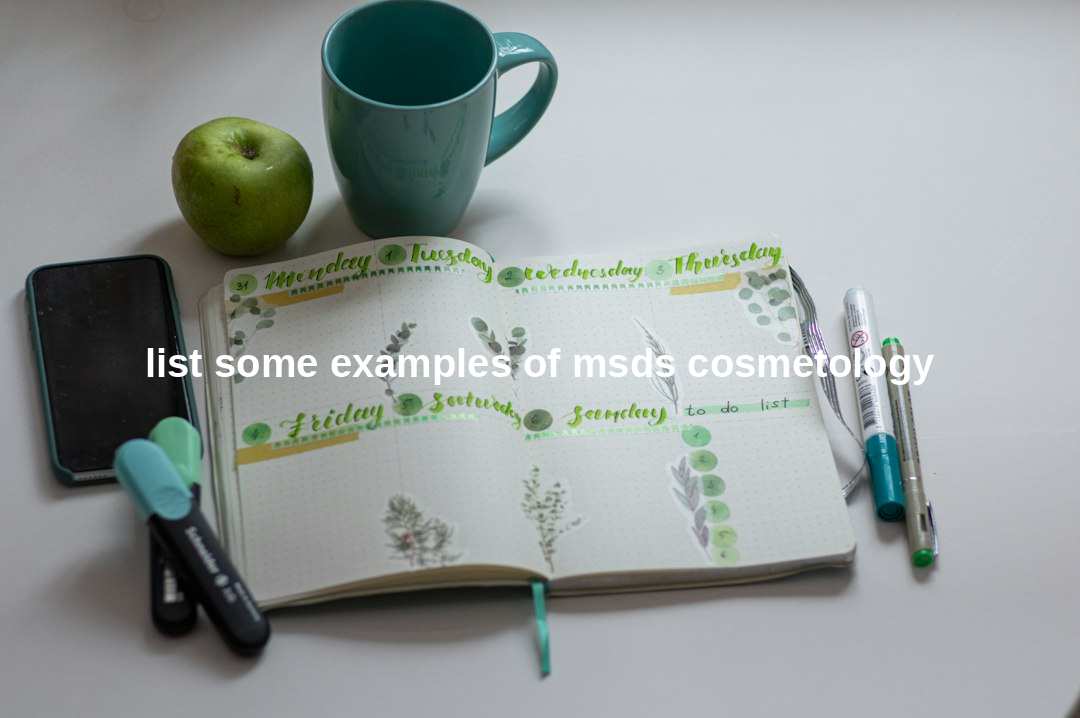Navigating the world of cosmetology requires not only a keen sense for style and trends but also a rigorous adherence to health and safety protocols. Among the most critical components in promoting a safe environment for both beauty professionals and clients is the use of Material Safety Data Sheets (MSDS). An MSDS provides vital information about the chemicals in the products used in a salon setting, outlining potential hazards, handling procedures, and emergency protocols. For cosmetologists, understanding and utilizing MSDS is paramount to ensuring a safe workplace. To shed light on the subject, let’s list some examples of MSDS cosmetology through which professionals can appreciate the diversity and necessity of these documents in their everyday practice.
| Product Category | Hazard Identification | Handling and Storage | First Aid Measures |
|---|---|---|---|
| Hair Dyes | May contain allergens and irritants | Store in a cool, dry place away from light | Rinse affected area with water, seek medical attention if necessary |
| Nail Polish Removers | Flammable, may cause dizziness if inhaled | Keep away from open flames, use in a well-ventilated area | In case of inhalation, move to fresh air and consult a physician |
| Hair Relaxers | Can cause skin and eye burns | Do not expose to moisture, keep containers tightly closed | Wash skin thoroughly after handling, for eye contact, rinse thoroughly for several minutes |
| Skin Care Products | Potential for allergic reactions | Follow the specific product guidelines for optimal shelf life | For reactions, discontinue use immediately and consult a healthcare provider |
The Importance of MSDS in Cosmetology for Safety and Health
The hair and beauty industry frequently utilizes a broad range of chemicals that, while essential for the services offered, can pose various health risks if not managed correctly. Exposure to certain substances found in cosmetology products can lead to skin irritations, respiratory issues, or even more severe health concerns over time. Consequently, the role of MSDS in mitigating these risks cannot be overstated.
Preventing Health Hazards
For cosmetologists, the comprehensive knowledge of the products they use daily is critical to prevent occupational illnesses. The MSDS serves as a safety net, informing users about the proper usage, potential hazards, and correct storage of cosmetic products. This information is crucial for minimizing exposure to harmful substances.
By understanding the components outlined within the MSDS, cosmetologists are better equipped to protect themselves and their clients from adverse effects. These sheets offer guidance on personal protective equipment (PPE), such as gloves or masks, that should be worn when handling certain chemicals. They also detail emergency procedures in the event of accidental exposure, ensuring that quick and efficient action can be taken to minimize harm.
Moreover, the MSDS contains important information for effectively responding to spills or other accidents within the salon. It includes details on safe cleanup practices and proper disposal methods for hazardous materials, thus protecting not only the salon staff and customers but also the environment.
Finally, the MSDS is an essential tool for cosmetology education and training. It is imperative for instructors to incorporate these data sheets in their teaching, emphasizing the significance of understanding and adhering to safety protocols. This training helps to instill a culture of safety within the beauty industry, which is vital for protecting the well-being of all involved.
Typical Cosmetology Products Requiring MSDS

When we list some examples of MSDS cosmetology, we are essentially identifying products with potential chemical risks. Typical cosmetology products requiring MSDS include hair colorants, permanent solutions, nail polishes, removers, and various skincare products.
Hair Care Products
Hair care products like shampoos, conditioners, dyes, and bleaches often contain a variety of chemicals that can affect the skin or respiratory system. For cosmetologists, knowing the contents and hazards as detailed in the MSDS is imperative for safe usage.
Nail Products
The nail salon industry uses an array of products which may contain toxic substances like formaldehyde or toluene. MSDS sheets for nail polishes, hardeners, and removers disclose details on handling, storage, and first-aid, ensuring the safety of nail technicians and clients alike.
Skincare and Makeup
While skincare and makeup products are designed to enhance beauty, they may sometimes contain allergens or irritants. Estheticians and makeup artists rely on MSDS for information on proper usage and potential risks associated with these cosmetic products.
Understanding MSDS Components and Their Role in Cosmetic Safety
The role of MSDS in cosmetic safety is pivotal, as it lists the necessary information to understand each product’s nature, usage, and disposal. It is the blueprint for safety regarding the handling of cosmetology products.
Section Breakdown
An MSDS typically includes sections such as product identification, hazard identification, composition/information on ingredients, first-aid measures, fire-fighting measures, accidental release measures, handling and storage, exposure controls/personal protection, physical and chemical properties, stability and reactivity, toxicological information, ecological information, disposal considerations, transport information, regulatory information, and other information.
Safety Procedures and Personal Protection
Part of the MSDS’s value lies in its detailed safety procedures and recommended personal protective equipment (PPE). The document advises on how to safely handle the chemicals to minimize exposure risks.
First-Aid and Emergency Protocols
The MSDS is crucial for informing staff of first-aid procedures and emergency protocols in case of an incident. This ensures a quick and informed response to prevent serious health consequences.
Regulatory Bodies Overseeing MSDS Compliance in the Beauty Industry
Regulatory bodies play a crucial role in overseeing list some examples of MSDS cosmetology, ensuring that companies comply with safety standards and that professionals are informed of potential hazards associated with cosmetic products.
Occupational Safety and Health Administration (OSHA)
In the United States, OSHA is the primary federal agency charged with the enforcement of safety and health legislation. OSHA requires that MSDS be available for all applicable products and ensures that employees are trained on their use.
Environmental Protection Agency (EPA)
The EPA also has regulations that impact the use of certain chemicals in the beauty industry. It works to ensure that potential environmental hazards are properly managed and disclosed in the MSDS.
State Cosmetology Boards
State boards specifically regulate the beauty industry. They ensure local compliance with federal guidelines and can provide additional safety requirements pertaining to cosmetology products and their usage.
Conclusion: Emphasizing the Need for MSDS Education in Cosmetology Institutions
In conclusion, the Material Safety Data Sheets serve as an essential guide for safety within the cosmetology industry. They provide detailed chemical information and vital protocols for handling and emergency situations, significantly reducing the risk of harm. It is, therefore, of utmost importance that cosmetologists are well-versed in interpreting and applying the information found within MSDS. This brings us back to the crucial point that we must list some examples of MSDS cosmetology in educational settings to ensure that upcoming professionals are prepared to maintain the highest standards of health and safety in their future practice.
- MSDS is a key document that details the safe handling, storage, and use of cosmetology products, outlining potential risks and first-aid measures.
- Typical cosmetology products that require an MSDS include hair dyes, nail polish removers, hair relaxers, and skincare products.
- Key components of MSDS provide information on product ingredients, hazard identification, safe usage guidelines, and emergency contact details.
- Regulatory bodies such as OSHA, EPA, and state cosmetology boards are responsible for enforcing MSDS compliance and promoting workplace safety.
- Cosmetology education institutions must prioritize MSDS training to prepare students for the realities of working with hazardous substances in the beauty industry.


